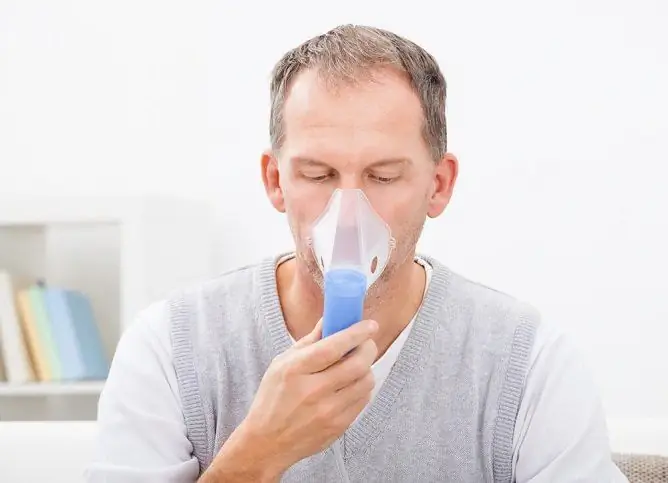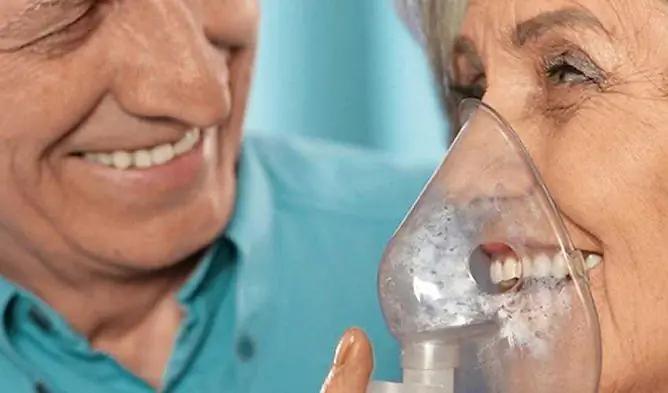- Author Rachel Wainwright [email protected].
- Public 2023-12-15 07:39.
- Last modified 2025-11-02 20:14.
Ventolin nebula
Ventolin nebula: instructions for use and reviews
- 1. Release form and composition
- 2. Pharmacological properties
- 3. Indications for use
- 4. Contraindications
- 5. Method of application and dosage
- 6. Side effects
- 7. Overdose
- 8. Special instructions
- 9. Application during pregnancy and lactation
- 10. Use in childhood
- 11. Drug interactions
- 12. Analogs
- 13. Terms and conditions of storage
- 14. Terms of dispensing from pharmacies
- 15. Reviews
- 16. Price in pharmacies
Latin name: Ventolin Nebules
ATX code: R03AC02
Active ingredient: salbutamol (salbutamol)
Producer: Aspen Bad Oldesloe (Germany)
Description and photo updated: 22.11.2018
Prices in pharmacies: from 228 rubles.
Buy

Ventolin nebula is a bronchodilating drug, a selective beta2-adrenergic agonist.
Release form and composition
Ventolin nebula is available in the form of a solution for inhalation: a clear liquid with a color from colorless to light yellow [2.5 ml each in nebulas (polyethylene ampoules), 10 nebulas are soldered together in a strip, in bags of laminated aluminum foil 1 strip, in cardboard box 1, 2, 3, 5 or 6 packages].
1 ml of solution contains:
- active substance: salbutamol sulfate - 1.2 mg, which corresponds to the content of 1 mg of salbutamol;
- auxiliary components: sulfuric acid (diluted to pH 3.5-4.5), sodium chloride, purified water.
Pharmacological properties
Pharmacodynamics
The bronchodilating effect of Ventolin nebula is due to the activity of salbutamol. Being a selective agonist of beta2-adrenergic receptors, its therapeutic doses have an effect on the beta2-adrenergic receptors of the smooth muscles of the bronchi and cause a bronchodilator effect within 1/12 hour against the background of reversible airway obstruction. The action of the drug lasts from 4 to 6 hours.
Pharmacokinetics
As a result of inhalation, from 10 to 20% of the used dose of salbutamol reaches the lower respiratory tract, about 80% remains in the inhaler or oropharynx. From the oropharynx, the drug enters the digestive tract. The fraction that enters the respiratory tract is absorbed into the lung tissue and blood.
Plasma protein binding - 10%.
In the lungs, salbutamol is not metabolized; when it enters the systemic circulation, it undergoes hepatic metabolism.
After absorption from the gastrointestinal tract of the swallowed part of the inhalation dose, there is a significant metabolism of salbutamol during the first passage through the liver with the formation of phenolic sulfate.
With intravenous administration of salbutamol, T1 / 2 is 4 to 6 hours.
The drug is excreted mainly through the kidneys unchanged and in the form of a phenolic sulfate conjugate. A small part of the received dose of the drug is excreted through the intestines. Complete elimination occurs within 72 hours.
Indications for use
- chronic bronchitis, chronic obstructive pulmonary disease, pulmonary emphysema and other chronic lung pathologies, accompanied by reversible airway obstruction - as part of complex therapy;
- prevention and relief of bronchial asthma attacks, including complex therapy of status asthmaticus.
Contraindications
- use with the threat of abortion or for the conduct of premature uncomplicated childbirth;
- age up to 1.5 years;
- hypersensitivity to the components of the drug.
Care should be taken when prescribing Ventolin nebula for inhalations with thyrotoxicosis, arterial hypertension, severe chronic heart failure, tachyarrhythmias, pheochromocytoma, during pregnancy, during breastfeeding, after previous therapy with high doses of other sympathomimetics.
Instructions for the use of Ventolin nebula: method and dosage
Do not use Ventolin nebula for injection or oral administration!
The solution is intended for inhalation use only by inhalation through the mouth using a nebulizer (inhaler) and a face mask, T-shaped or endotracheal tube. In addition, it can be used in ventilation mode with intermittent positive pressure. In this case, to reduce the risk of hypoxia, the inhaled air can be enriched with oxygen.
The procedure must be performed under the supervision of a doctor in a well-ventilated area.
The solution is ready to use undiluted. If the procedure lasts more than 10 minutes, it can be diluted with sterile 0.9% sodium chloride solution.
The laminated aluminum foil bag must be opened before the actual procedure. Holding the strip with one hand, separate one nebula with the other hand, turning the outermost one down and away from you. The nebules in the strip are lowered back into the bag and placed in a cardboard box. To open the nebula, it is necessary to turn its body, holding the apex. The open end of the nebula is placed in the nebulizer chamber. Slowly squeezing its body, all contents are completely poured into the inhaler. Further, the nebulizer is used in accordance with the instructions for its use, making sure that the "mist" formed as a result of inhalation does not enter the patient's eyes.
If the doctor prescribed diluted Ventolin nebulas for the procedure, then the recommended amount of sterile 0.9% sodium chloride solution must be added to the salbutamol solution in the nebulizer chamber. After closing the lid of the nebulizer chamber, shake its contents thoroughly to mix the solutions.
After inhalation, the solution remaining in the nebulizer chamber must be removed.
Recommended dosage: the average initial dose is 2.5 mg, if necessary, it is shown to be increased to 5 mg. The frequency of inhalations can be 4 times a day. To achieve a therapeutic effect in the treatment of severe airway obstruction in adults in a hospital setting, up to 40 mg of salbutamol per day can be used under the close supervision of a specialist.
Concurrent oxygen therapy should be considered to reduce the risk of transient hypoxemia.
Side effects
- from the respiratory system, chest and mediastinal organs: very rarely - paradoxical bronchospasm;
- from the immune system: very rarely - hypersensitivity reactions (including urticaria, bronchospasm, angioedema, arterial hypotension, collapse);
- on the part of nutrition and metabolism: rarely - hypokalemia (including clinically significant hypokalemia); very rarely - lactic acidosis;
- from the digestive system: infrequently - irritation of the mucous membrane of the mouth and pharynx;
- from the nervous system: often - headache, tremor; very rarely - increased activity;
- from the side of the vessels: rarely - peripheral vasodilation;
- from the heart: often - tachycardia; infrequently - palpitations; very rarely - atrial fibrillation, supraventricular tachycardia, extrasystole and other types of arrhythmias;
- from the musculoskeletal system: infrequently - muscle cramps.
Overdose
Symptoms: hypokalemia, lactic acidosis (rapid shallow breathing, bronchospasm).
Treatment: the appointment of symptomatic therapy, control of the concentration of potassium and lactate in the blood serum.
special instructions
The use of Ventolin nebula should be made in strict accordance with the doctor's prescription.
Since the need to increase the dose of the drug or the frequency of procedures may be a sign of an exacerbation of bronchial asthma, it is necessary to clarify the treatment regimen and consider the advisability of prescribing the simultaneous administration of glucocorticosteroids.
Patients for whom the drug is prescribed for home use should be informed that in case of a decrease in the therapeutic effect or its duration, it is necessary to immediately consult a doctor, since it is strictly forbidden to increase the dose or increase the frequency of inhalations on their own.
A step-by-step method of treating bronchial asthma under the control of lung function and the patient's clinical response to treatment is recommended.
In case of unstable or severe bronchial asthma, Ventolin nebula should not be the main or only drug of therapy.
The sudden progression of the worsening of the course of bronchial asthma poses a threat to human life, therefore, an immediate appointment or an increase in the dose of GCS is required. In this case, the patient needs daily monitoring of the maximum expiratory flow rate.
It should be borne in mind that the use of beta2-adrenergic receptor agonists can cause the development of hypokalemia, especially with inhalation or parenteral administration. Patients with severe attacks of bronchial asthma need regular careful monitoring of serum potassium levels, since they are at greater risk of hypokalemia due to hypoxia and combination therapy with GCS, xanthine derivatives and diuretics.
According to the instructions, Ventolin Nebula should be canceled immediately if the patient develops immediately after inhalation of paradoxical bronchospasm with increased wheezing. The immediate treatment of this condition requires the use of another short-acting inhaled bronchodilator or salbutamol in an alternative form.
Do not allow the solution or its "mist" to get into the eyes.
With the simultaneous inhalation of salbutamol and anticholinergic drugs (including ipratropium bromide), caution should be exercised, since there is a risk of developing acute angle-closure glaucoma.
In patients with diabetes mellitus against the background of the use of salbutamol, decompensation and ketoacidosis may develop. They should be especially careful when combining the drug with GCS.
With an exacerbation of bronchial asthma, the use of high doses of Ventolin nebula can cause shortness of breath and compensatory hyperventilation of the lungs. When diagnosing a deterioration in a patient's condition, it is necessary to take into account the possibility of developing lactic acidosis, which manifests itself with similar symptoms. Serum lactate concentration studies should be used to correctly interpret these signs and to take measures to prevent the development of metabolic acidosis.
Application during pregnancy and lactation
During the period of gestation and breastfeeding, the appointment of inhalations of salbutamol is allowed only if the expected therapeutic effect for the mother significantly exceeds the potential threat to the fetus or child.
It is believed that the use of salbutamol during pregnancy can cause the development of various malformations in the fetus, including the formation of a cleft palate, malformations of the limbs, although a causal relationship has not been established.
The effect of Ventolin nebula on fertility has not been established.
Pediatric use
The use of the drug for the treatment of children under 1.5 years of age is contraindicated due to the lack of information on the clinical efficacy of nebulized salbutamol at this age.
Drug interactions
With the simultaneous use of Ventolin nebula:
- propranolol and other non-selective beta-adrenergic receptor blockers: not recommended;
- stimulants of the central nervous system: enhance their effect, tachycardia;
- cardiac glycosides: increase the likelihood of developing extrasystole;
- theophylline and other anticholinergics (xanthines): increase the risk of developing tachyarrhythmias, promote an increase in intraocular pressure;
- levodopa, inhalation anesthesia: increase the likelihood of severe ventricular arrhythmias;
- diuretics, GCS: increase the risk of developing or increasing hypokalemia;
- monoamine oxidase inhibitors: the pharmacological properties of each drug are not impaired.
Analogs
Analogs of Ventolin nebula are Ventolin, Ventolin Light Breath, Fenoterol, Onbrez Breezhaler, Ventilor, Nebutamol, Salamol-Eco, Salamol Steri-Neb, Salamol-Eco Light Breath, Salbutamol, Salbutamol-Neo, Salbutamol.
Terms and conditions of storage
Keep out of the reach of children.
Store at temperatures up to 30 ° C.
The shelf life is 3 years.
After breaking the tightness of the package, the drug should be stored in a dark place at temperatures up to 30 ° C for 3 months.
Terms of dispensing from pharmacies
Dispensed by prescription.
Reviews about Ventolin nebula
Reviews of Ventolin nebulas for inhalation are positive. They indicate the effectiveness and rapid therapeutic effect of the drug in the treatment of both obstructive bronchitis and attacks of bronchial asthma. Inhalation contributes to the relief of a strong dry cough and the positive dynamics of sputum excretion in various pulmonary pathologies. Patients note the good tolerance of the procedures, the absence of pronounced adverse reactions, including in the treatment of children.
Some patients report developing addiction to the drug.
Price for Ventolin nebula in pharmacies
The price of Ventolin nebula for a package containing 20 nebulas can range from 283 rubles.
Ventolin nebula: prices in online pharmacies
|
Drug name Price Pharmacy |
|
Ventolin Nebula 1 mg / ml solution for inhalation 2.5 ml 20 pcs. 228 r Buy |
|
Ventolin nebula solution for ing 1mg / ml 2.5ml 20 pcs. 281 r Buy |

Anna Kozlova Medical journalist About the author
Education: Rostov State Medical University, specialty "General Medicine".
Information about the drug is generalized, provided for informational purposes only and does not replace the official instructions. Self-medication is hazardous to health!






